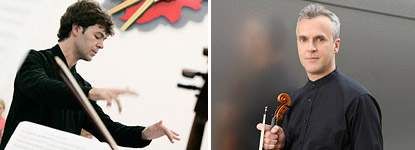Martin Chalifour was brilliant in the West Coast premiere of James Matheson’s Violin Concerto on March 2 at Walt Disney Concert Hall.
The Concerto was co-commissioned by the Los Angeles Philharmonic and the Chicago Symphony Orchestra and was premiered in both venues, by different conductors, with different soloists. The Chicago premiere featured Baird Dodge and Esa-Pekka Salonen; and this Los Angeles premiere with Chalifour, LA Phil principal concertmaster since 1995, was an experience to remember. Conductor Pablo Heras-Casado returned for his fifth time to Walt Disney Concert Hall; his first appearance was a Green Umbrella experience, and I think he was a good choice to conduct Matheson’s work.
The opening, “Caprice,” began with Chalifour frenetically playing a rapid, repetitive figure. He was agitated and driven, but still maintained control and direction while humming above the orchestral soundscape with its contrasting large lyric lines and sonic mass. I could hear echoes of Philip Glass. The violin would rise and fall above the orchestral level and at times would even move from the foreground to apparently support the weight of the orchestra’s sound. Chalifour’s melody was full of life and vitality; it was superhuman as he lured the listener with its magically dynamic spinning quality.
The second movement, “Chaconne,” was beautiful and original. Chalifour’s now-calmed instrument was set against his pianissimo first violins; his lower register was robust in the richness of its tone. Then we heard him rip the concluding “Dance” with a blinding solo virtuosity. Eventually a more familiar sound evolved with a syncopated jazz-like quality driven by slapping pizzicatos and culminating in a bold, almost pop-like coda driven by a booming bass drum crescendo in a pounding, absurdist modern manner. The coda surprised me, but it was effective. I enjoyed all three movements immensely, each in a unique way, and I thought that Chalifour showed amazing endurance and that he was magnificent in his mastery of this devilishly difficult piece.
The orchestration was large with extra players across the woodwinds and brass sections, and the percussion sported loads of heavy metal, in addition to a piano, celesta and harp. The most interesting timbres came from string and percussion effects, although the individual tonal capabilities of the woodwinds were overlooked. However, collectively the woodwinds did produce an interesting three-dimensional effect, with motifs splashing across the stage physically in space and time while controlling the chroma and tone-height of individual notes to give an Escher-like, illusory swirling sensation.
Strauss’ Ein Heldenleben (A Hero’s Life) followed without intermission, and as usual, was performed without pauses, except for a dramatic grand pause at the end of the first movement. Heras-Casado’s tempo was brisk; he generally kept a high level of tension that showed visibly in the language of his hands and neck. Associate Concertmaster Nathan Cole brought us a wonderfully tender extended cadenza.
The Casual Fridays series features a shorter program without intermission where the performers and audience dress casually and have the opportunity for conversation after the concert. Matheson talked about the acoustics of the two halls in which his work was played, and he noted that the liveliness of Disney Hall compared to Chicago’s Orchestra Hall allowed him to better hear the details of his orchestration. The sound was quite good, and the mix between Chalifour and the orchestra was flawless.
~Theodore Bell/Culture Spot LA






